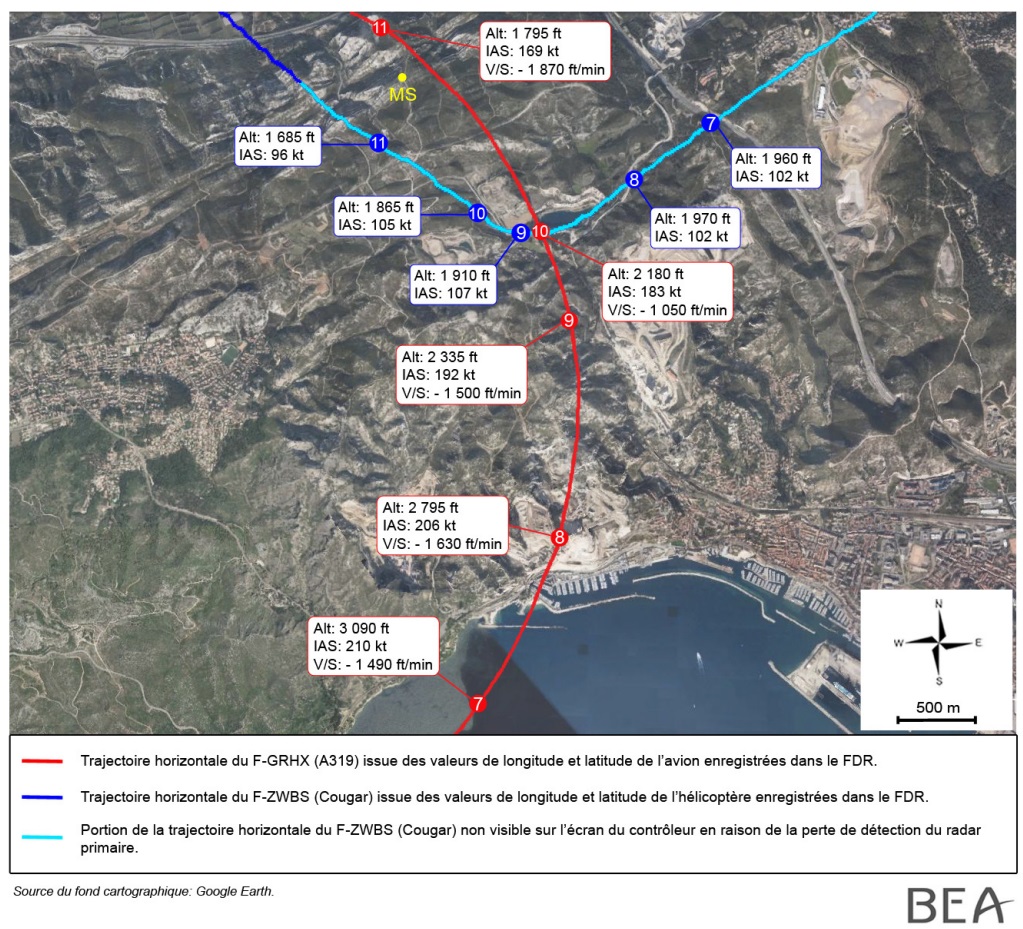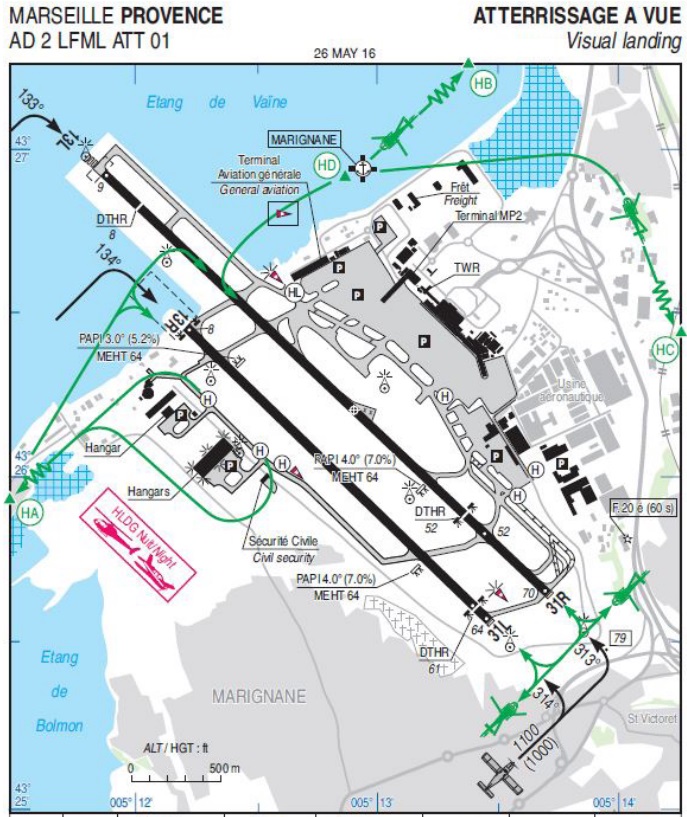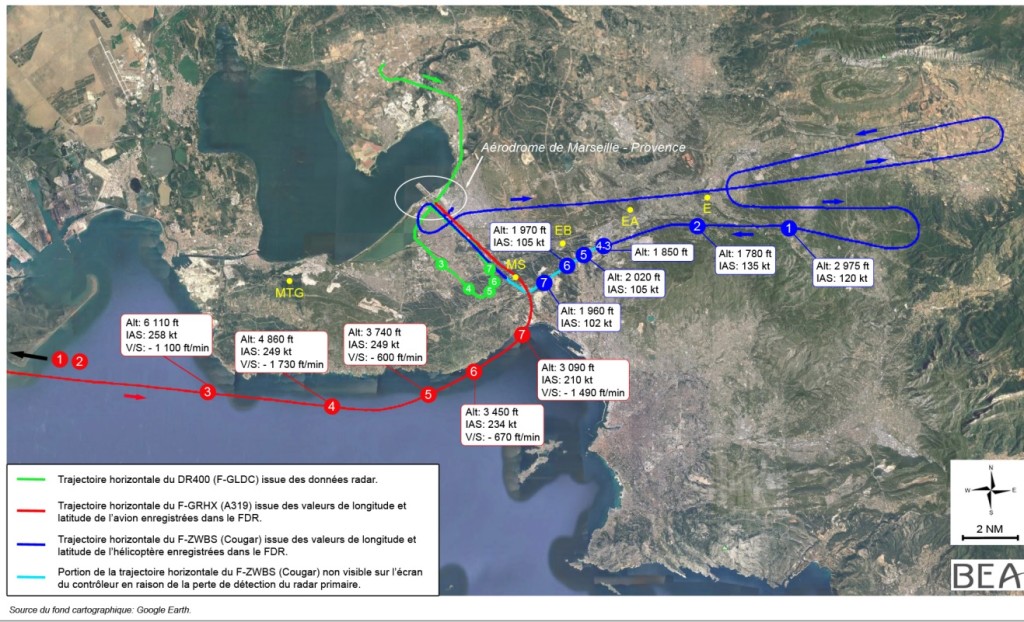A319 / Cougar Airprox at MRS: ATC Busy, Failed Transponder and Helicopter Filtered From Radar
On 27 June 2016, Air France Airbus A319 F-GRHX, with 132 people onboard, passed Airbus Helicopters Cougar F-ZWBS with a minimum separation of 0.2 nm horizontally and 240 ft vertically on approach to Marseille-Provence Airport (close to the points marked ’10’ below).
According to the Bureau d’Enquêtes et d’Analyses (BEA) investigation report (published only in French), the helicopter was returning from a VFR test flight to the east of the airport. Its transponder had failed in flight so air traffic control only had primary radar contact. The BEA comment this hazard may have been underestimated and there was excessive confidence in the primary radar’s tracking.
The helicopter crew were told they would land behind a Lufthansa A320 on Runway 31R by the Tower Controller. They were shortly after told to land on 32L instead.
The Air France, operated for Hop!, was performing a visual approach to Runway 31R and were also told they were number 2 behind the A320 by the Approach Controller. They were unaware of the presence of the helicopter. The Tower frequency was noted to be busy (it was active for about 80% of the time, which is very high use say the BEA). The investigators note that use of non-standard phraseology in French contributed significantly to the congestion of the tower frequency.
While on base leg, the Cougar crew slowed significantly and came into the hover at point 3. The primary radar then automatically filtered out the slow moving target (the cyan track below), even when the speed increased.
The Cougar crew were meanwhile visually searching for a Robin DR400 light aircraft that was to the west. As they crossed the approach to 31R to intersect 31L they were unaware that the A319 was behind them and closing. It as at this point the minimum separation occurred.
The A319’s TCAS could not detect the helicopter because of the faulty helicopter transponder. Visual acquisition was difficult as the helicopter, intended for a military customer, was camouflaged and being viewed against the ground. The BEA comment that the closing speed “also makes it difficult to apply the concept of ‘see and to avoid”. The BEA comment that the helicopter crew, being Marseilles based, has been able to develop mutual trust with the local controllers. So, as the crews are familiar with the terrain, there was less rigour in position reports and the controllers may haven been less vigilant in tracking them. While this might be adequate normally, it could aggravate unexpected event.
Other MAC Safety Resources
Aerossurance has previously published:
- Military Mid Air Collisions
- Military Airprox in Sweden
- North Sea S-92A Helicopter Airprox Feb 2017
- Mid Air Collision Typhoon & Learjet 35
- USMC CH-53E Readiness Crisis and Mid Air Collision Catastrophe
- Avoiding Mid Air Collisions: 5 Seconds to Impact
- AAIB Highlight Electronic Conspicuity and the Limitations of See and Avoid after Mid Air Collision
- Fatal Biplane/Helicopter Mid Air Collision in Spain, 30 December 2017
- UPDATE 16 February 2019: Merlin Night Airprox: Systemic Issues
- UPDATE 12 May 2019: Alaskan Mid Air Collision at Non-Tower Controlled Airfield
- UPDATE 14 August 2021: Alpine MAC ANSV Report: Ascending AS350B3 and Descending Jodel D.140E Collided Over Glacier
- UPDATE 18 June 2022: Limitations of See and Avoid: Four Die in HEMS Helicopter / PA-28 Mid Air Collision
Aerossurance has extensive air safety, operations, airworthiness, human factors, aviation regulation and safety analysis experience. For practical aviation advice you can trust, contact us at: enquiries@aerossurance.com
Follow us on LinkedIn and on Twitter @Aerossurance for our latest updates.




Recent Comments